10Gbps Fiber SFP+ Module | Multi Mode Dual LC Transceiver | up to 300 Meter | Multiple Network Switch Compatible
These Fiber SFP+ modules is 100% compatible with generic sfp+ coding brands such as Tenda, Hikvision, TPLink, TrendNet, Netgear, Cudy, Ubiquiti / Unifi and generic OEM brands.
This SFP+ Module is Hot-Pluggable and it can be inserted into a Network or POE Network Switch without the need to power-down the switch.
Please see our guide at Fiber Optic Cables & SFP Compatibility for more information.
Product Features
- Hot-Pluggable
- Duplex LC receptacle
- 850nm VCSEL transmitter, PIN photo-detector
- Capable of over 300m transmission on OM3 MMF (Multimode Fiber) and 400m on OM4 MMF
- 2-wire interface for management specifications compliant with SFF 8472 digital diagnostic monitoring interface
- Power Supply :+3.3V
- Power consumption<1W
- Temperature Range: 0~ +70°C
- RoHS compliant

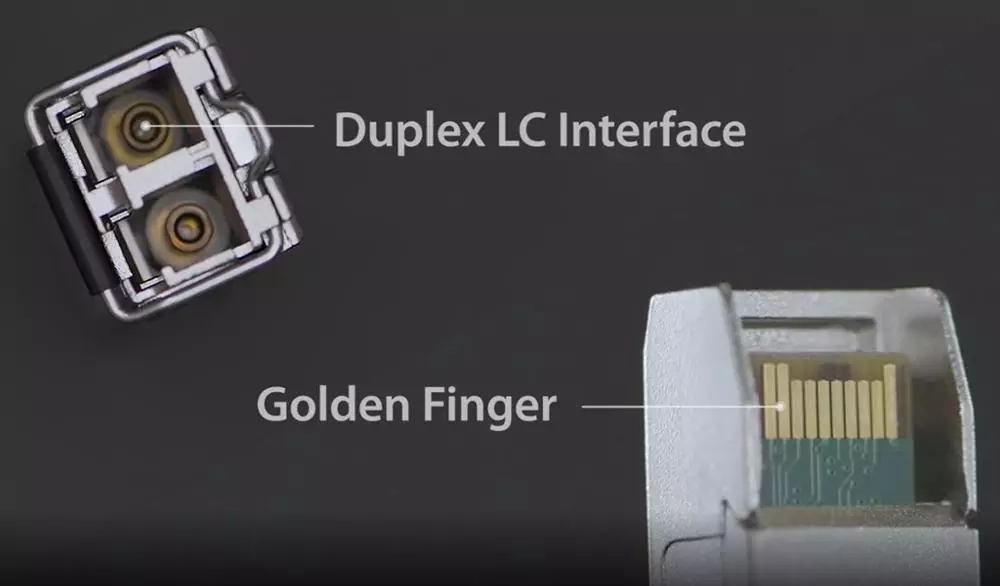
Applications
- 10GBASE-SR/SW Ethernet
- SONET OC-192&SDH STM-64
- OTN ITU-T G.709
- 10X Fibre Channel
- LTE systems
- Other Optical links
Example of Dual LC Fiber SFP Installation
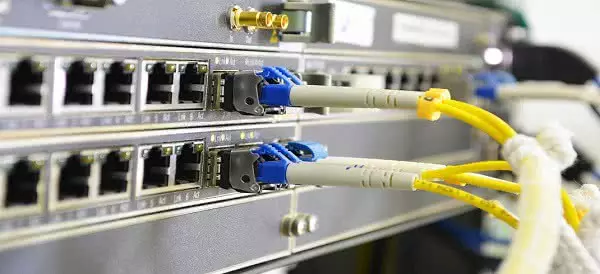
Standard
- Compliant with SFF-8472 SFP+ MSA.
- Compliant to SFP+ SFF-8431 and SFF-8432.
- Compliant to 802.3ae 10GBASE-SR.
- RoHS Compliant
Product Description
- This SFP+ Module is a very compact 10Gb/s optical transceiver module for serial optical communication applications at 10Gb/s. It converts a 10Gb/s serial electrical data stream to 10Gb/s optical output signal and a 10Gb/s optical input signal to 10Gb/s serial electrical data streams. The high speed 10Gb/s electrical interface is fully compliant with SFI specification.
- The high performance 850nm VCSEL transmitter and high sensitivity PIN receiver provide superior performance for Ethernet applications at up to 300m links.
- The SFP+ Module compliant with SFF-8431, SFF-8432 and IEEE 802.3ae 10GBASE-SR. Digital diagnostics functions are available via a 2-wire serial interface, as specified in SFF-8472.
- The fully SFP compliant form factor provides hot pluggability, easy optical port upgrades and low EMI emission.
These Dual LC SFP+ Modules are commonly installed with the Duplex Multi Mode LC to LC Fiber Cables Below:
1M Duplex MultiMode OM3 Fiber Cable | UPC LC-LC Fiber Cable | Fiber Patch Cord
Absolute Maximum Ratings
| Parameter | Symbol | Min. | Typical | Max. | Unit |
| Storage Temperature | TS | -40 | +85 | °C | |
| Case Operating Temperature | TOP | 0 | +70 | °C | |
| Maximum Supply Voltage | Vcc | -0.5 | 4 | V | |
| Relative Humidity | RH | 0 | 85 | % |
Optical Characteristics
| Parameter | Symbol | Min. | Typical | Max. | Unit | Note |
| Transmitter | ||||||
| Center Wavelength | λt | 840 | 850 | 860 | nm | |
| RMS spectral width | λRMS | 4 | nm | |||
| Average Optical Power | Pavg | -7.3 | -1 | dBm | 1 | |
| Optical Power OMA | Poma | -1.5 | dBm | |||
| Laser Off Power | Poff | -30 | dBm | |||
| Extinction Ratio | ER | 3.5 | dB | |||
| Transmitter Dispersion Penalty | TDP | 3.9 | dB | 2 | ||
| Relative Intensity Noise | Rin | -128 | dB/Hz | 3 | ||
| Optical Return Loss Tolerance | 20 | dB | ||||
| Receiver | ||||||
| Center Wavelength | λr | 840 | 860 | nm | ||
| Receiver Sensitivity (OMA) | Sen | -11.1 | dBm | 4 | ||
| Stressed Sensitivity (OMA) | SenST | -7.5 | dBm | 4 | ||
| Los Assert | LOSA | -30 | – | dBm | ||
| Los Dessert | LOSD | -12 | dBm | |||
| Los Hysteresis | LOSH | 0.5 | dB | |||
| Overload | Sat | 0 | dBm | 5 | ||
Notes:
- Average power figures are informative only, per IEEE802.3ae.
- TWDP figure requires the host board to be SFF-8431compliant. TWDP is calculated using the Matlab code provided in clause 68.6.6.2 of IEEE802.3ae.
- 12dB reflection.
- Conditions of stressed receiver tests per IEEE802.3ae. CSRS testing requires the host board to be SFF-8431 compliant.
- Receiver overload specified in OMA and under the worst comprehensive stressed condition.
Electrical Characteristics
| Parameter | Symbol | Min. | Typical | Max. | Unit | Note |
| Supply Voltage | Vcc | 3.135 | 3.465 | V | ||
| Supply Current | Icc | 250 | mA | |||
| Power Consumption | P | 1 | W | |||
| Transmitter | ||||||
| Input differential impedance | Rin | 100 | Ω | 1 | ||
| Tx Input Single Ended DC Voltage Tolerance (Ref VeeT) | V | -0.3 | 4 | V | ||
| Differential input voltage swing | Vin,pp | 180 | 700 | mV | 2 | |
| Transmit Disable Voltage | VD | 2 | Vcc | V | 3 | |
| Transmit Enable Voltage | VEN | Vee | Vee+0.8 | V | ||
| Receiver | ||||||
| Single Ended Output Voltage Tolerance | V | -0.3 | 4 | V | ||
| Rx Output Diff Voltage | Vo | 300 | 850 | mV | ||
| Rx Output Rise and Fall Time | Tr/Tf | 30 | ps | 4 | ||
| LOS Fault | VLOS fault | 2 | VccHOST | V | 5 | |
| LOS Normal | VLOS norm | Vee | Vee+0.8 | V | 5 | |
Notes:
- Connected directly to TX data input pins. AC coupling from pins into laser driver IC.
- Per SFF-8431 Rev 3.0
- Into 100 ohms differential termination.
- 20%~80%
- LOS is an open collector output. Should be pulled up with 4.7k – 10kΩ on the host board. Normal operation is logic 0; loss of signal is logic 1. Maximum pull-up voltage is 5.5V.
Timing Characteristics
| Parameter | Symbol | Min. | Typical | Max. | Unit |
| TX_Disable Assert Time | t_off | 10 | us | ||
| TX_Disable Negate Time | t_on | 1 | ms | ||
| Time to Initialize Include Reset of TX_FAULT | t_int | 300 | ms | ||
| TX_FAULT from Fault to Assertion | t_fault | 100 | us | ||
| TX_Disable Time to Start Reset | t_reset | 10 | us | ||
| Receiver Loss of Signal Assert Time | TA,RX_LOS | 100 | us | ||
| Receiver Loss of Signal Deassert Time | Td,RX_LOS | 100 | us | ||
| Rate-Select Change Time | t_ratesel | 10 | us | ||
| Serial ID Clock Time | t_serial-clock | 100 | kHz |
Pin Assignment
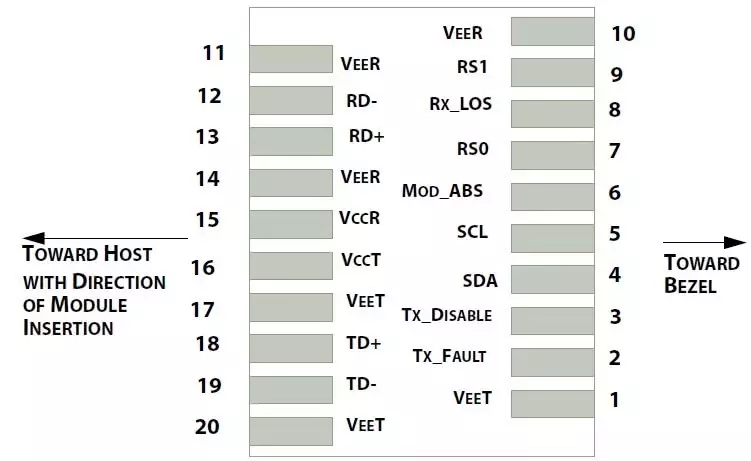
Diagram of Host Board Connector Block Pin Numbers and Name
Pin Function Definitions
| Pin | Symbol | Name/Description | NOTE |
| 1 | VEET | Transmitter Ground (Common with Receiver Ground) | 1 |
| 2 | TFAULT | Transmitter Fault. | 2 |
| 3 | TDIS | Transmitter Disable. Laser output disabled on high or open. | 3 |
| 4 | SDA | 2-wire Serial Interface Data Line | 4 |
| 5 | SCL | 2-wire Serial Interface Clock Line | 4 |
| 6 | MOD_ABS | Module Absent. Grounded within the module | 4 |
| 7 | RS0 | Rate Select 0 | 5 |
| 8 | LOS | Loss of Signal indication. Logic 0 indicates normal operation. | 6 |
| 9 | RS1 | No connection required | 1 |
| 10 | VEER | Receiver Ground (Common with Transmitter Ground) | 1 |
| 11 | VEER | Receiver Ground (Common with Transmitter Ground) | 1 |
| 12 | RD- | Receiver Inverted DATA out. AC Coupled |
Notes:
- Circuit ground is internally isolated from chassis ground.
- T FAULT is an open collector/drain output, which should be pulled up with a 4.7k – 10k Ohms resistor on the host board if intended for use. Pull up voltage should be between 2.0V to Vcc + 0.3V.A high output indicates a transmitter fault caused by either the TX bias current or the TX output power exceeding the preset alarm threshold. A low output indicates normal operation. In the low state, the output is pulled to <0.8V.
- Laser output disabled on TDIS>2.0V or open, enabled on TDIS <0.8V.
- Should be pulled up with 4.7kΩ- 10kΩ host board to a voltage between 2.0V and 3.6V. MOD_ABS pulls line low to indicate module is plugged in.
- Internally pulled down per SFF-8431 Rev 4.1.
- LOS is open collector output. It should be pulled up with 4.7kΩ – 10kΩ on host board to a voltage between 2.0V and 3.6V. Logic 0 indicates normal operation; logic 1 indicates loss of signal.
EEPROM Information and Management
The SFP+ transceivers support the 2-wire serial communication protocol as defined in the SFP MSA.
The standard SFP serial ID provides access to identification information that describes the transceiver’s capabilities, standard interfaces, manufacturer, and other information.
Additionally, The SFP+ transceivers provide a unique enhanced digital diagnostic monitoring interface, which allows real-time access to device operating parameters such as transceiver temperature, laser bias current, transmitted optical power, received optical power and transceiver supply voltage. It also defines a sophisticated system of alarm and warning flags, which alerts end-users when particular operating parameters are outside of a factory set normal range.
The SFP MSA defines a 256-byte memory map in EEPROM that is accessible over a 2-wire serial interface at the 8 bit address 1010000X (A0h).The digital diagnostic monitoring interface makes use of the 8 bit address 1010001X (A2h), so the originally defined serial ID memory map remains unchanged.
The operating and diagnostics information is monitored and reported by a Digital Diagnostics Transceiver Controller (DDTC) inside the transceiver, which is accessed through a 2-wire serial interface. When the serial protocol is activated, the serial clock signal (SCL, Mod Def 1) is generated by the host. The positive edge clocks data into the SFP transceiver into those segments of the E2PROM that are not write-protected. The negative edge clocks data from the SFP transceiver. The serial data signal (SDA, Mod Def 2) is bi-directional for serial data transfer. The host uses SDA in conjunction with SCL to mark the start and end of serial protocol activation. The memories are organized as a series of 8-bit data words that can be addressed individually or sequentially.
Table 1. Digital Diagnostic Memory Map (Specific Data Field Descriptions)
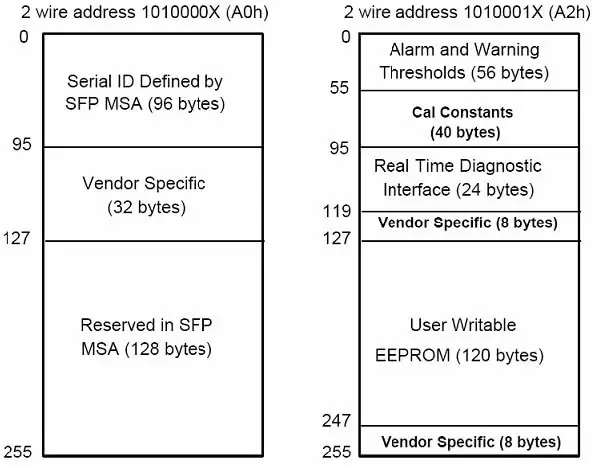
Table 2 – EEPROM Serial ID Memory Contents (A0h)
| Data Address | Length (Byte) | Name of Length | Description and Contents |
| Base ID Fields | |||
| 0 | 1 | Identifier | Type of Serial transceiver (03h=SFP) |
| 1 | 1 | Reserved | Extended identifier of type serial transceiver (04h) |
| 2 | 1 | Connector | Code of optical connector type (07=LC) |
| 3-10 | 8 | Transceiver | 10G Base-XX |
| 11 | 1 | Encoding | 64B/66B |
| 12 | 1 | BR, Nominal | Nominal baud rate, unit of 100Mbps |
| 13-14 | 2 | Reserved | (0000h) |
| 15 | 1 | Length(9um) | Link length supported for 9/125um fiber, units of 100m |
| 16 | 1 | Length(50um) | Link length supported for 50/125um fiber, units of 10m |
| 17 | 1 | Length(62.5um) | Link length supported for 62.5/125um fiber, units of 10m |
| 18 | 1 | Length(Copper) | Link length supported for copper, units of meters |
| 19 | 1 | Reserved | |
| 20-35 | 16 | Vendor Name | SFP+ vendor name |
| 36 | 1 | Reserved | |
| 37-39 | 3 | Vendor OUI | SFP+ transceiver vendor OUI ID |
| 40-55 | 16 | Vendor PN | Part Number |
| 56-59 | 4 | Vendor rev | Revision level for part number |
| 60-62 | 3 | Reserved | |
| 63 | 1 | CCID | Least significant byte of sum of data in address 0-62 |
| Extended ID Fields | |||
| 64-65 | 2 | Option | Indicates which optical SFP signals are implemented(001Ah = LOS, TX_FAULT, TX_DISABLE all supported) |
| 66 | 1 | BR, max | Upper bit rate margin, units of % |
| 67 | 1 | BR, min | Lower bit rate margin, units of % |
| 68-83 | 16 | Vendor SN | Serial number (ASCII) |
| 84-91 | 8 | Date code | Manufacturing date code |
| 92-94 | 3 | Reserved | |
| 95 | 1 | CCEX | Check code for the extended ID Fields (addresses 64 to 94) |
| Vendor Specific ID Fields | |||
| 96-127 | 32 | Readable | specific date, read only |
| 128-255 | 128 | Reserved | Reserved for SFF-8079 |
Digital Diagnostic Monitor Characteristics
| Data Address | Parameter | Accuracy | Unit |
| 96-97 | Transceiver Internal Temperature | ±3.0 | °C |
| 98-99 | VCC3 Internal Supply Voltage | ±3.0 | % |
| 100-101 | Laser Bias Current | ±10 | % |
| 102-103 | Tx Output Power | ±3.0 | dB |
| 104-105 | Rx Input Power | ±3.0 | dB |
Regulatory Compliance
The SFP+ complies with international Electromagnetic Compatibility (EMC) and international safety requirements and standards (see details in Table following).
| Feature | Reference | Performance |
| Electrostatic discharge(ESD) | IEC/EN 61000-4-2 | Compatible with standards |
| Electromagnetic Interference (EMI) | FCC Part 15 Class B EN 55022 Class B (CISPR 22A) | Compatible with standards |
| Laser Eye Safety | FDA 21CFR 1040.10, 1040.11 IEC/EN 60825-1, 2 | Class 1 laser product |
| Component Recognition | IEC/EN 60950, UL | Compatible with standards |
| ROHS | 2002/95/EC | Compatible with standards |
| EMC | EN61000-3 | Compatible with standards |
Recommended Circuit
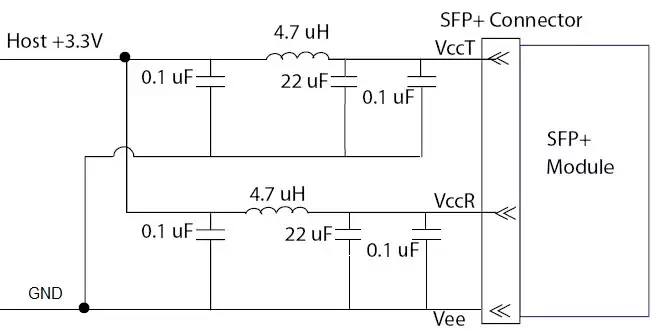
Recommended Host Board Power Supply Circuit
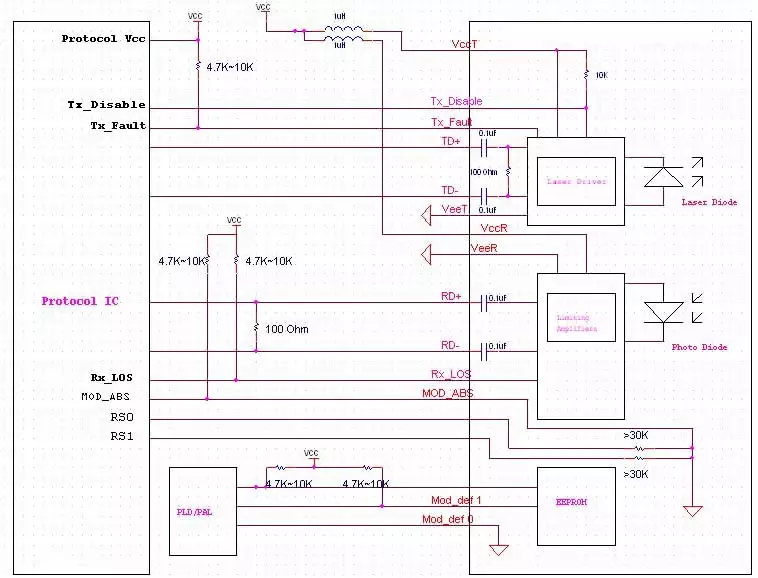
Host – Transceiver Interface Block Diagram
Outline Dimensions
Comply to SFF-8432 rev. 5.0, the improved Pluggable form factor specification.
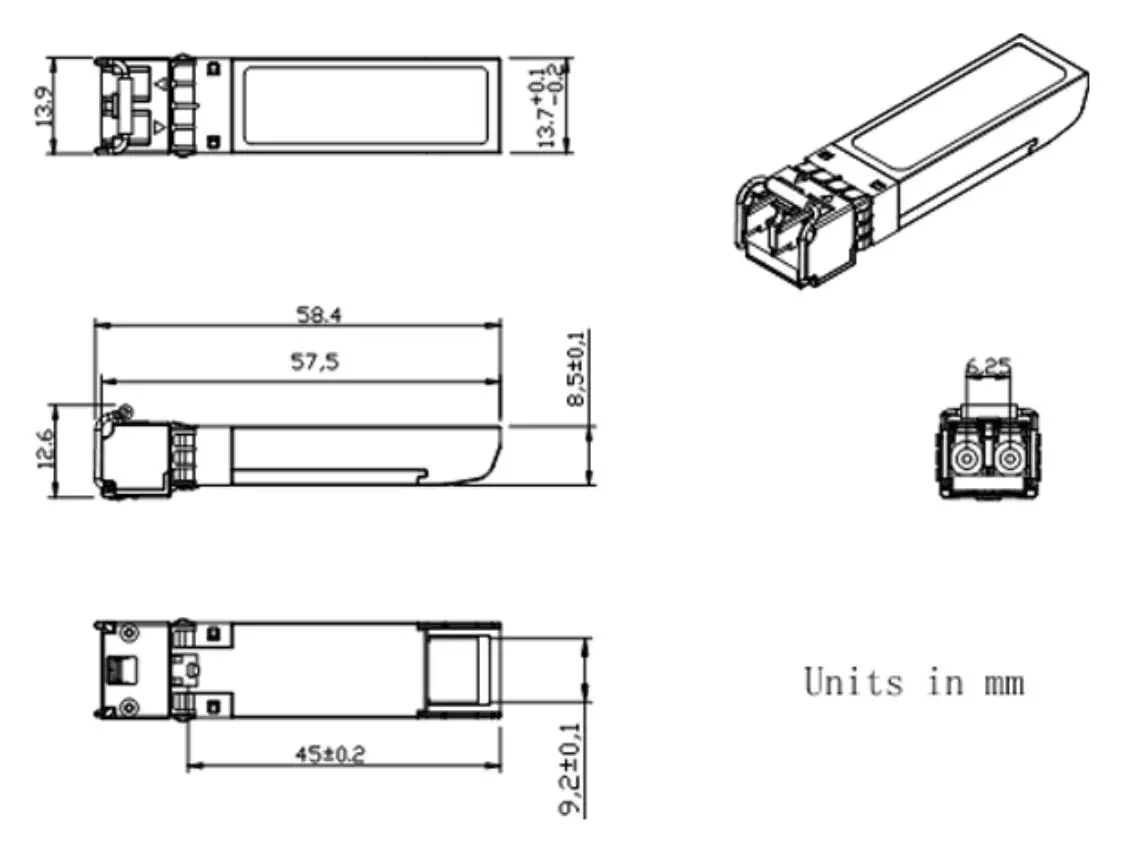
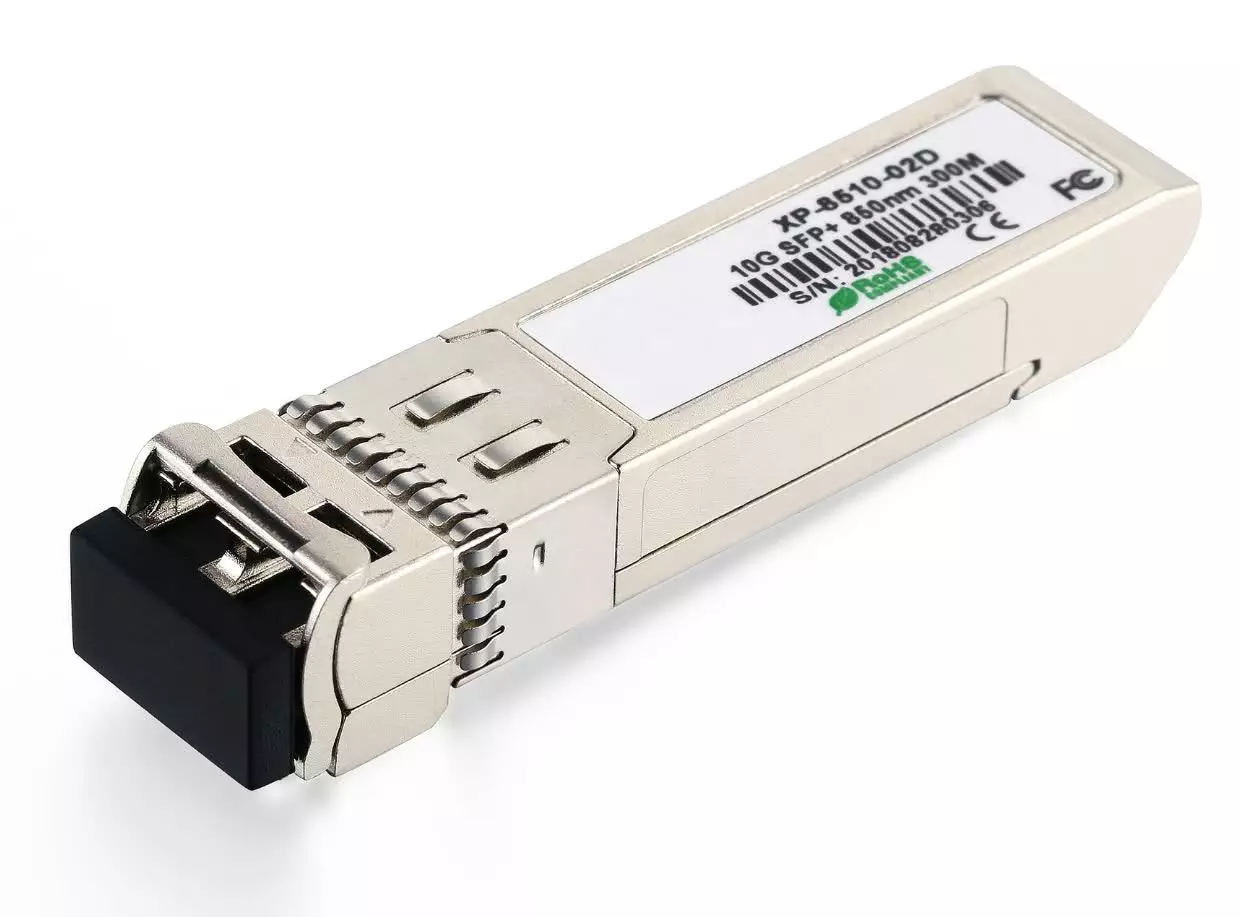

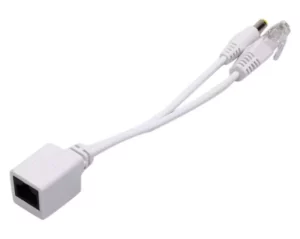
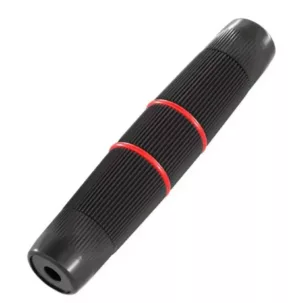
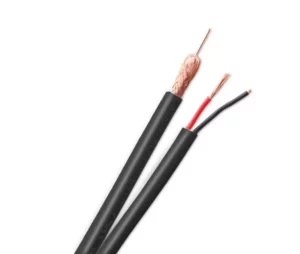

Reviews
There are no reviews yet.